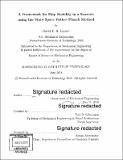A framework for ship stability in a seastate using the state-space Fokker-Planck method
Author(s)
Larson, David F. H
DownloadFull printable version (4.727Mb)
Other Contributors
Massachusetts Institute of Technology. Department of Mechanical Engineering.
Advisor
Paul D. Sclavounos.
Terms of use
Metadata
Show full item recordAbstract
Ships sailing on the ocean have many inherent dangers. One of the most compelling is when they interact with severe stochastic waves, resulting in a loss of stability and adversely affecting their operation. This can result in extreme motions, at the very least making life difficult for crew, to potentially the most catastrophic events capsize, and loss of cargo and life. This compels the need to reliably predict vessel responses to wave interactions in order to aid the decision-making process for operating the ship safely. Despite the advances in computational methods and stochastic hydrodynamic theories to this date, a general framework, capable of handling nonlinear three-dimensional effects, arbitrary wave headings and unconventional hull geometries, is still missing from the engineer's toolbox. This thesis presents a new methodology for modeling the nonlinear responses and stability of a ship in stochastic waves. Invoking the weak-scatterer hypothesis, the radiation and diffraction effects are linearized, computed via a panel method, and cast into a state-space form, aided by applying the ESPRIT algorithm. Strong free surface nonlinearities present in the Froude-Krylov exciting and hydrostatic restoring forces are modeled by Fluid Impulse Theory. In parallel, the ambient seastate is represented by a multidimensional stochastic differential equation (SDE) conforming to a prescribed spectrum. Combining the state-space and seastate models capacitates the study of the nonlinear seakeeping and stability of a ship in a broad range of stationary seastates via stochastic calculus methods. Chief among them is the use of the Fokker-Planck equation (FPE), a deterministic partial differential equation governing the joint probability density function of the states of the SDE. The formulation for a rectangular barge rolling in beam waves is presented, with the approach readily extendable to six-degree-of-freedom responses. By deriving a state-space stochastic differential equation for the states governing the vessel response motions, the joint probability density can be found either by numerical Monte-Carlo simulation of the SDE, or by numerically solving the associated FPE.
Description
Thesis: S.M., Massachusetts Institute of Technology, Department of Mechanical Engineering, 2018. Cataloged from PDF version of thesis. Includes bibliographical references (pages 91-93).
Date issued
2018Department
Massachusetts Institute of Technology. Department of Mechanical EngineeringPublisher
Massachusetts Institute of Technology
Keywords
Mechanical Engineering.